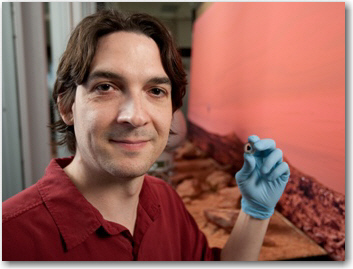Through the study of a popular Martian meteorite’s age, a University of Houston professor
and his team have made significant discoveries about the timeline of volcanic activity
on Mars.
Thomas Lapen, assistant professor of geosciences at UH, describes his team’s findings
in a paper titled “A Younger Age for ALH84001 and its Geochemical Link to Shergottite
Sources in Mars,” appearing April 16 in Science, the world’s leading journal of original scientific research, global news and commentary.

Lapen and his colleagues’ data showed that the true age of this meteorite is 4.091
billion years old, about 400 million years younger than earlier age estimates. They
concluded that this stone formed during an important time when Mars was wet and had
a magnetic field, conditions that are favorable for the development of simple life.
This finding precludes ALH84001 from being a remnant of primordial Martian crust,
as well as confirming that volcanic activity was ongoing in Mars over much of its
history.
“This research helps us better refine the history of Mars,” Lapen said. “This has
huge ramifications for our understanding of volcanic processes active in Mars and
for the nature of deeper portions of the planet that are sources of magmas that produced
the largest volcanoes in the solar system. These data also are used to refine models
of initial planetary formation and early evolution.”
With the crystallization age and formation of this rock being debated since its discovery
in 1984, Lapen and his team seized an opportunity to better refine the early history
of Mars. With samples provided by the NASA Antarctic meteorite curator and the meteorite
working group, the researchers used a relatively new method that has never been applied
to this stone – lutetium-hafnium isotope analysis.
“We studied variations in isotopic compositions of minerals to determine the age and
sources of magmas that produced these rocks,” Lapen said. “We uncovered evidence
that the volcanic systems in Mars were likely active more than four billion years.
This connection allows the possibility that regions with the largest volcanoes in
the solar system perhaps host some of the longest-lived volcanic systems in the solar
system.”
In addition to Lapen, the team includes Alan Brandon, an associate professor in UH’s
department of earth and atmospheric sciences, and their two post-doctoral researchers
Minako Righter and John Shafer. Other collaborators were Brian Beard from the University
of Wisconsin-Madison and NASA Astrobiology Institute, Vinciane Debaille from the University
of Bruxelles and Anne Peslier, a research scientist at Jacobs Technology working at
NASA Johnson Space Center.
The project was supported by NASA Cosmochemistry grants to Lapen and Brandon, a NASA
Astrobiology grant to Beard and a grant from UH’s own Institute for Space Systems
Operations to Lapen. The Belgian Fund for Scientific Research provides current financial
support to Debaille. The research took about 15 months.
Video 1: Overview of Findings
Video 2: UH Professor Thomas Lapen, In His Own Words
NOTE TO JOURNALISTS: Video and a high-resolution photo of Thomas Lapen are available to media by contacting
Lisa Merkl.
About the University of Houston
The University of Houston is a comprehensive national research institution serving
the globally competitive Houston and Gulf Coast Region by providing world-class faculty,
experiential learning and strategic industry partnerships. UH serves 37,000 students
in the nation’s fourth-largest city in the most ethnically and culturally diverse
region in the country.
About the College of Natural Sciences and Mathematics
The UH College of Natural Sciences and Mathematics, with 170 ranked faculty and approximately
4,500 students, offers bachelor’s, master’s and doctoral degrees in the natural sciences,
computational sciences and mathematics. Faculty members in the departments of biology
and biochemistry, chemistry, computer science, earth and atmospheric sciences, mathematics
and physics conduct internationally recognized research in collaboration with industry,
Texas Medical Center institutions, NASA and others worldwide.
For more information about UH, visit the university’s Newsroom at http://www.uh.edu/news-events/.
To receive UH science news via e-mail, visit http://www.uh.edu/news-events/mailing-lists/sciencelistserv.php.
For additional news alerts about UH, follow us on Facebook and Twitter.